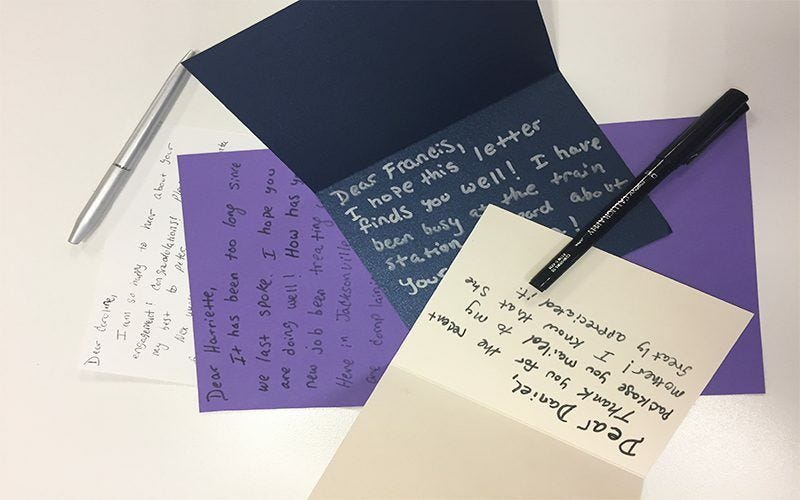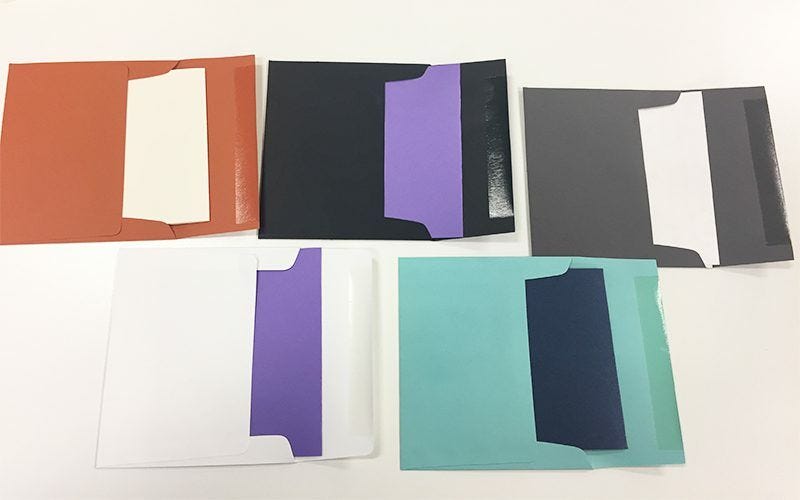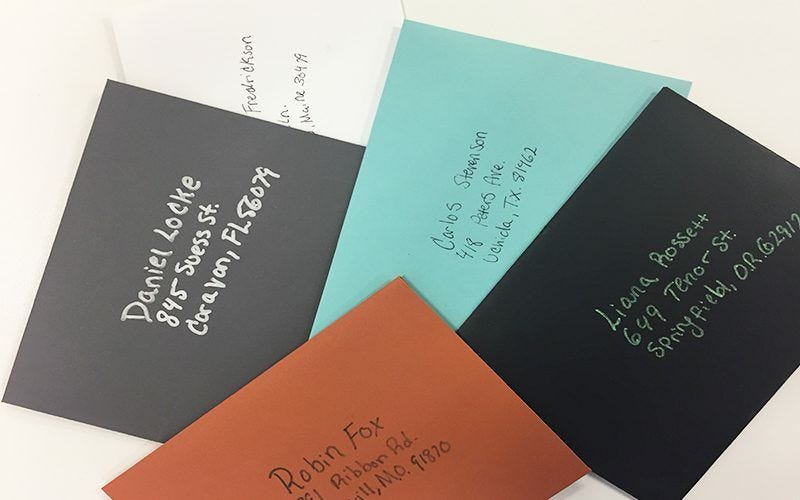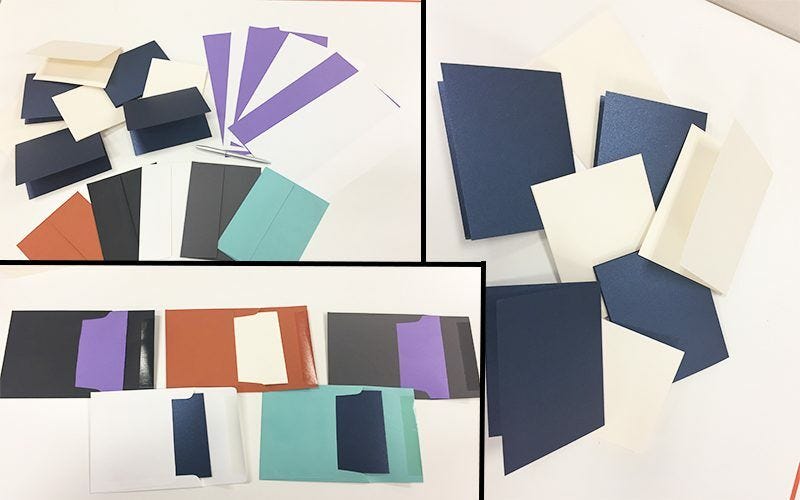5 Reasons You Should Still Write and Send Letters
- By Andrew Jacobs
- Feb 8, 2017
5 Reasons You Should Still Write and Send Letters
Letters?!
In a society where we are in constant communication with others through our phones and computers, it might be hard to imagine why you would need another way to speak to friends or relatives. Especially if that other method of communication takes more than a few minutes of your day.
Can’t you just send a quick text or Snap Chat and be done with it?
But imagine for a moment that you had an ample amount of space to say everything you wanted to a person, before they had an opportunity to interrupt or change the subject.
That’s one of the many advantages of the under-practiced, all-but-lost art of letter-writing.
The classic and long-enduring practice of writing letters first decreased in popularity with the advent of email, and has been dwindling ever since with the development of texting and the ever-advancing social media.
While these modern forms of communication may seem easier and more sensible, they do not have all the same benefits as the good old-fashioned, hand-written letter.
So what are these benefits? Why should a person living in the 21st century bother with writing letters to friends and loved ones? Let’s explore some of the reasons!
1. You can say everything and anything you want, with zero interruptions.
When you sit down to write a letter, you have a platform to say what you need to say with absolutely no interruptions. This is important because sometimes it's just easier (and more efficient) to explain yourself or something when there’s no one there to interject or put a twist on things—intentional or otherwise.
This is radically different from texting. When texting someone, most of us tend to text in short blurbs that give people the opportunity to respond right away. Even if you’re not done talking, the ball is immediately in the other person's court the instant you press “send”.
Whereas when you write a letter, you can express your thoughts fully in complete paragraphs. The recipient of your letter then has a chance to take in everything you've written as a whole and reflect on it before forming their own carefully thought-out response.
2. You have time to think through what you say and how you say it.
Because letters are usually longer and take some time to compose, you’re automatically inclined to put a lot more thought into them. Spending time on a letter allows you to be much more intentional with what you express and to carefully consider your word choice.
Most of us can relate to having said things we didn't mean or sending texts we ended up regretting. If you write something you want to take back in a letter, you can simply erase it or start over.
The finished product becomes something well-polished and fully deliberate. Your recipient will read and receive the words you truly mean to say!
3. You can make it look great.
One of the best parts of writing letters is choosing fun and colorful paper, stationery, and—of course—envelopes! These components can add a lot of personality to your letter.
Want to write serious or fancy letters? You can use white or ivory paper and stationery. If you want to set a more fun-loving tone, use purple or green paper, or colorfully boarded stationery! There’s a wide variety of paper and stationery sets to choose from out there that can reflect your personal style and mood of your letter.
Picking the right paper to write on, and the right envelope to send your letter in, is half the fun of letter-writing. Not the most confident in your handwriting? That's okay! Letters can be composed in writing or print. This brings me to my next point:
4. It’s fun to write letters!
If you’re a story-teller like me, or simply someone who enjoys chatting, writing letters will be a very enjoyable practice! Re-tell the recent events of your life or share your deepest, personal thoughts.
Written or printed, letter-writing is a great opportunity to be fully expressive and to add more depth to your relationships. Letters give us the opportunity to bring joy to those who are feeling depressed, friendship and intimacy to the lonely, and much more! Have fun with your letters as well as with the people you address them to!
5. It’s fun for the recipient to receive mail!

Because letter-writing is so rare in our culture these days, it can be even more exciting to receive something in the mail that's not a bill or advertisement! Letter recipients will be glad that you are thinking of them and that you care enough to take the time out of your day to write them a long and detailed discourse. From the moment they take the letter out of the mailbox to the moment they finish reading your final phrase, your recipient will have an unmatched experience.
Want to get started? Check out some paper, envelopes, and note cards for your letter-writing endeavors on the JAM Paper® website!
Edited by Dana Kim on 3/25/2020.
Why You Should Still Write and Send Letters
In today's digital age, the art of writing and sending letters may seem outdated, but there are still many reasons why it is a meaningful and valuable practice. Firstly, writing and sending letters allows for a personal and heartfelt connection that cannot be replicated through a text or email. It shows the recipient that you took the time and effort to craft a thoughtful message just for them. Additionally, receiving a physical letter in the mail can bring a sense of joy and excitement that is often lost in the digital world. Writing letters also provides an opportunity for self-expression and creativity, allowing you to convey your thoughts and feelings in a unique and personal way. Furthermore, letters can serve as cherished keepsakes that can be revisited and treasured for years to come. Finally, sending letters can be a way to support the postal service and keep the tradition of handwritten communication alive. Overall, there are many reasons why writing and sending letters is still a meaningful and worthwhile practice in today's modern world.
The Benefits of Writing and Sending Letters
There are numerous benefits to writing and sending letters that go beyond the act of communication itself. One of the main benefits is the emotional impact it can have on both the sender and the recipient. Writing letters allows for a deeper level of connection and intimacy, fostering stronger relationships and meaningful connections. Additionally, the act of writing can be therapeutic and cathartic, providing a creative outlet for self-expression and reflection. Sending letters can also be a way to show appreciation, gratitude, and love to those in your life, strengthening bonds and creating lasting memories. Furthermore, letters can serve as historical records, providing a tangible and personal account of events and emotions that can be cherished for generations. Overall, the benefits of writing and sending letters extend far beyond the simple act of communication, enriching our lives in meaningful and profound ways.
Use Cases for Writing and Sending Letters
While the practice of writing and sending letters may seem old-fashioned, there are still many relevant and meaningful use cases for this traditional form of communication. One common use case is to express gratitude and appreciation to loved ones, friends, or colleagues. Sending a heartfelt letter can convey a level of sincerity and thoughtfulness that is often lost in digital communication. Another use case is to maintain long-distance relationships, as letters can serve as a tangible and personal connection when physical distance separates us. Additionally, writing letters can be a way to document and preserve important memories and milestones, creating a personal archive of life's significant moments. Furthermore, letters can be used to convey important news, announcements, or invitations in a more formal and personal manner. Overall, there are many relevant and meaningful use cases for writing and sending letters in today's modern world.
Alternatives to Writing and Sending Letters
While writing and sending letters is a meaningful and traditional form of communication, there are also modern alternatives that offer convenience and efficiency. One popular alternative is to send emails, which provide a quick and easy way to communicate with others, especially for more time-sensitive or informal messages. Another alternative is to use social media platforms or messaging apps, which allow for instant and interactive communication with friends and family. Additionally, video calls and virtual meetings offer a way to connect face-to-face with others, even when physical distance separates us. However, it's important to note that these alternatives may lack the personal and heartfelt touch that comes with writing and sending letters, making them less suitable for certain types of communication. Overall, while there are modern alternatives to writing and sending letters, they may not always capture the same level of intimacy and personal connection.
Tips for Writing and Sending Letters
If you're interested in reviving the art of writing and sending letters, there are a few tips to keep in mind to make the experience more enjoyable and meaningful. Firstly, take the time to choose quality stationery and writing materials that reflect your personal style and taste. This can add a special touch to your letters and make the experience more enjoyable for both you and the recipient. Additionally, consider the content and tone of your letters, aiming to convey sincerity, warmth, and thoughtfulness in your words. It's also important to take the time to address and format your letters properly, as this attention to detail can enhance the overall presentation and impact. Finally, consider incorporating personal touches such as photos, drawings, or small mementos to make your letters even more special and memorable. Overall, these tips can help you make the most of the experience of writing and sending letters, creating meaningful and cherished connections with others.
Why Writing and Sending Letters Still Matters
Despite the prevalence of digital communication, writing and sending letters still hold a significant and meaningful place in our lives. The act of writing and sending letters allows for a level of personal connection and intimacy that cannot be replicated through other forms of communication. It provides an opportunity for self-expression, creativity, and reflection, allowing us to convey our thoughts and feelings in a unique and personal way. Additionally, letters can serve as cherished keepsakes that capture important moments and emotions, providing a tangible and lasting connection to the past. Furthermore, writing and sending letters can be a way to support the postal service and keep the tradition of handwritten communication alive. Overall, writing and sending letters still matters in today's modern world, offering a meaningful and valuable way to connect with others and create lasting memories.






















